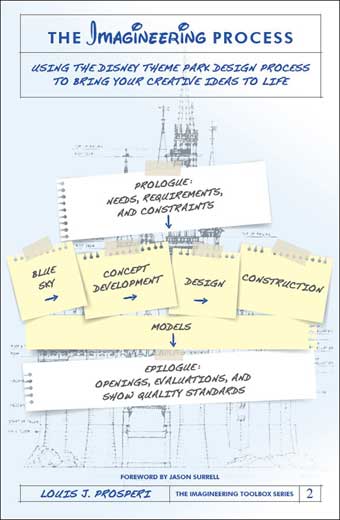It’s a common dream for Disney fans; what would it be like to work as an Imagineer? The thought of spending our time designing theme park attractions sounds incredible. On the other hand, we have almost no concept of how much work and skill goes into this position. We tend to focus on the “imagine” portion and skip “engineer”.
When you look beyond the surface, much of the effort in this role involves parts of corporate jobs that sound dull — especially project management. The process used by Disney Imagineering is complex and goes well beyond thinking up cool ideas. Louis J. Prosperi’s new book uncovers the mysteries of what it really means to be an Imagineer and how it connects to a wide range of other roles.
In The Imagineering Process: Using the Disney Theme Park Design Process to Bring Your Creative Ideas to Life, Prosperi describes each stage of an attraction’s development. It expands on his previous book The Imagineering Pyramid and focuses more on Disney’s actual process. This time, he starts with the needs that drive a new attraction and moves through each step up to the opening. For Disney fans that want to dive further into what Imagineering does, Prosperi offers a solid primer.
This title is the second volume in Prosperi’s Imagineering Toolbox Series, so it follows a similar format to The Imagineering Pyramid. Prosperi begins with a shorter overview called “Peeking Over the Berm” and closes with “Beyond the Berm” to connect with other fields. The main section covers the meat of Prosperi’s ideas, which focus on the process this time. It’s more down to earth than the pyramid but takes a similar approach. Prosperi seems like a writer with a lot of intellectual curiosity, and this book peeks inside his mind.
Following the Experts
The Imagineering Process is Prosperi’s look into how Imagineering works, and he clearly did extensive research. Former Imagineer Jason Surrell provides the book’s Foreward and talks about his experiences with theme park design. Prosperi includes countless quotes from business thinkers and experts on the parks. In the best examples, Prosperi uses clips to support his points with input from insiders. In his chapter about construction, he adds excerpts from Imagineers like Jason Grandt to explain that process. This choice makes sense to help us better understand how that step functions.
My favorite portions of the book connect directly to attractions and use them as examples to illuminate the activity. In his chapter on concept development, Prosperi describes how Imagineers develop the story for the attraction. They start with the basic concepts and then delves into additional details to provide the background. Prosperi shows how attractions like Big Thunder Mountain Railroad and the Twilight Zone Tower of Terror set the stage through small details that sell the story. He delves even further into Expedition Everest, which is one of the best modern examples of superb place making and storytelling by Imagineering.
The danger in providing so much background is losing narrative flow. Prosperi often uses quotes effectively to support his ideas, but a few sections go overboard and become a series of quotes. For example, the “Blue Sky” chapter offers valuable info, but the high volume of excerpts from other publications can be overwhelming. This book includes a lot of detailed material, but it only comes together with a smooth flow.
Not Just Disney
Some of my favorite sections in The Imagineering Process do more than describe what happens at Disney Imagineering. That content is a springboard to related topics apart from theme parks. My interest in the Apollo space program made the “Imagineering Apollo” section an easy sell. Prosperi goes well beyond just the basics of how we reached the Moon and connects the development of the Lunar Module (LM) to the process. He follows the same steps and shows how they connect to the many challenges with creating the LM.
Other sections look at Imagineering in game design, instructional design, and even a child’s birthday party. Prosperi has a personal background in these topics, which helps them stay relatable. Even so, I’m unsure if readers that don’t have knowledge in these areas will stick around for so much information about them. That doesn’t mean that the chapters won’t be helpful. I like the way that Prosperi is willing to go in-depth about each topic while still connecting the material to his overall process.
A Starting Point
One of the best aspects of The Imagineering Process is the appendix listing Prosperi’s extensive library of resources. I’ll definitely check out some of the books, magazines, and other materials that I haven’t read. Prosperi is passionate about Imagineering and theme parks in general. I’m interested in seeing where his research takes him next. If you share Prosperi’s excitement about Imagineering or are just looking for a motivational tool, this book should definitely help you on that journey.
Learn more about The Imagineering Process and purchase a copy on print. You can also follow Louis J. Prosperi on Twitter and visit his blog at The Imagineering Toolbox.
Related Articles: Louis J. Prosperi
The Imagineering Pyramid by Louis J. Prosperi (Review)
Beyond the Wisdom of Walt by Jeffrey A. Barnes (Review)
This post contains affiliate links. Making any purchase through those links supports this site. See full disclosure.




Leave a Reply